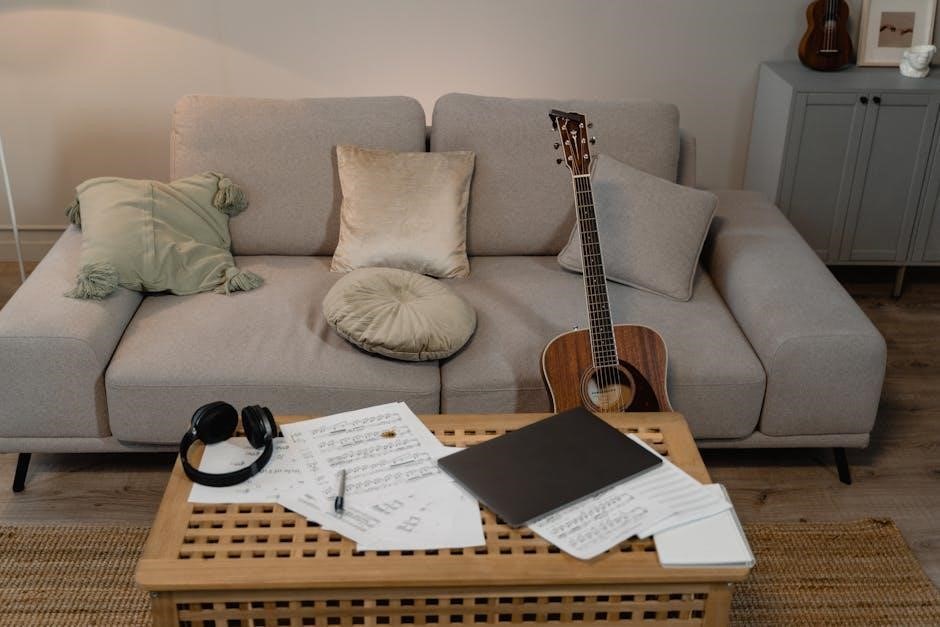Understanding violin dimensions is crucial for ensuring proper fit, playability, and sound quality․ Violins come in various sizes, from 1/32 to full size, catering to different age groups and arm lengths․ Correct measurements ensure comfort and technique, making it essential to choose the right size for optimal performance and musical experience․
Understanding the Importance of Violin Size
Violin size plays a critical role in ensuring comfort, proper technique, and optimal sound quality․ Choosing the right size is essential for players of all ages, as it directly impacts posture, finger placement, and overall performance․ A violin that is too large or too small can lead to discomfort, poor posture, and technical difficulties, potentially hindering progress and enjoyment․ The correct size ensures that the instrument fits naturally against the body, allowing for effortless playing and proper intonation․ Additionally, using a appropriately sized violin helps prevent long-term physical strain and supports the development of good playing habits․ For young learners, selecting the right size is particularly important to accommodate growing bodies and evolving skills․ Arm length and age are key factors in determining the ideal size, with detailed charts and expert guidance available to help make the best choice․ Proper sizing is the foundation for a lifelong appreciation and mastery of the violin․
Key Parts of the Violin and Their Measurements

The violin is composed of several key parts, each with specific measurements that contribute to its playability and sound quality․ The body length of a full-size violin typically measures around 14 inches (35․5 cm), while smaller sizes, such as 1/2 or 1/4, are proportionally reduced․ The width of the upper and lower bouts also varies, with the upper bout being narrower than the lower․ The string length, measured from the nut to the bridge, is approximately 12․75 inches (32․4 cm) for a full-size violin․ The neck length and fingerboard are designed for comfortable hand placement, with the fingerboard typically measuring around 12 inches (30․5 cm) in length․ Other critical dimensions include the bridge height, sound post placement, and bow length, which averages 29․5 inches (75 cm)․ These precise measurements ensure the violin’s structural integrity and acoustic performance, making it a highly refined musical instrument․

Standard Violin Dimensions for Different Sizes
Violins are available in various sizes to accommodate players of all ages and arm lengths․ The most common sizes range from 1/32 to 4/4 (full size)․ A full-size violin has a body length of approximately 14 inches (35․5 cm) and a total length, including the neck, of around 23 inches (58․4 cm)․ The 1/2 size violin is slightly smaller, with a body length of about 13 inches (33 cm), while the 1/4 size measures around 12 inches (30․5 cm)․ Each size is proportionally scaled down to maintain playability and sound quality․ The string length also decreases with smaller sizes, ensuring comfortable finger placement․ These standardized dimensions ensure that players, from young children to adults, can find an instrument that fits their needs, promoting proper technique and musical enjoyment․ Accurate sizing is essential for both comfort and performance quality․


Violin Size Chart and Sizing Guide

This guide provides a detailed chart to help determine the appropriate violin size based on age and arm length․ It ensures proper fit, comfort, and optimal playability for musicians of all levels and ages․
Violin Size Chart: From 1/32 to 4/4
Violin sizes range from 1/32 to 4/4, catering to players of all ages and arm lengths․ The 1/32 size is designed for young children, while the full-size 4/4 is standard for adults․ Each size has specific body length, width, and string length measurements to ensure proper fit and playability․ The chart below outlines these dimensions:
- 1/32: Body length 209mm, overall length 36․8cm
- 1/10: Body length 230mm, overall length 38․1cm
- 1/4: Body length 255mm, overall length 40․6cm
- 1/2: Body length 287mm, overall length 44․4cm
- 3/4: Body length 317mm, overall length 47․8cm
- 4/4: Body length 356mm, overall length 51․2cm
Using this chart ensures that players, especially children, can find an instrument that fits comfortably, promoting proper technique and enjoyment of playing․

How to Measure for the Right Violin Size
To determine the correct violin size, measure the player’s arm length from the base of the neck to the wrist․ This ensures the violin fits comfortably and allows proper playing technique․ Stand or sit up straight with the left arm extended to its full length․ Use a flexible tape measure or a straightedge to record the distance accurately․ Match this measurement to the violin size chart, which correlates arm length with instrument size․ For example, a 23․6-inch arm length typically suits a full-size (4/4) violin, while shorter arms may require smaller sizes like 1/2 or 1/4․ This method ensures the violin is proportionate to the player’s body, promoting comfort and proper posture․ Accurate measurement is vital for both beginners and experienced players to maintain sound quality and playability․
Age and Arm Length Recommendations
Choosing the right violin size is closely tied to the player’s age and arm length․ Generally, younger students require smaller violins, while older players and adults use full-size instruments․ For example, a 4/4 violin is typically recommended for individuals with an arm length of 23․6 inches or more, often corresponding to ages 11 and above․ A 3/4 violin suits arm lengths between 22․1 and 23․5 inches, ideal for students aged 9-11․ Smaller sizes, such as 1/2 or 1/4, are designed for younger children with shorter arm lengths․ While age provides a general guide, precise measurement of arm length ensures the best fit․ This approach avoids discomfort and technical difficulties, allowing players to maintain proper posture and finger placement; By aligning violin size with both age and arm length, musicians can enjoy optimal playability and sound quality․

Violin Dimensions and Sound Quality

Violin dimensions significantly impact sound quality․ Body length, width, and string length influence resonance and tone․ Proper measurements ensure balanced sound and playability, making precise proportions essential for optimal musical performance․
The Role of Body Length, Width, and String Length
The violin’s body length, width, and string length are critical factors in determining its sound quality․ A full-size violin typically has a body length of approximately 14 inches (35․5 cm) and a width of about 8․5 inches (21․6 cm)․ These dimensions provide optimal resonance and projection of sound․ The string length, measured from the nut to the bridge, is around 12․5 inches (31․8 cm), allowing for proper tension and playability․ Variations in these measurements, such as in smaller-sized violins, are proportionally adjusted to maintain tonal balance․ The body’s shape and size influence the instrument’s frequency response, with longer bodies producing deeper tones and wider bodies enhancing mid-range clarity․ String length affects the pitch and ease of playing, making precise measurements essential for both sound quality and player comfort․
How Dimensions Affect Playability and Tone
Violin dimensions significantly influence both playability and tone․ The body length and width determine the instrument’s comfort and accessibility, particularly for younger players or those with smaller frames․ A violin with proportional scaling ensures that the fingerboard and string length are appropriately sized, making it easier to press notes and navigate the frets․ The string length, which is the distance from the nut to the bridge, impacts the pitch and tension of the strings, directly affecting playability․ Smaller violins, such as 1/2 or 1/4 sizes, are scaled down to maintain proper pitch and tone while being easier to handle․ The thickness and graduation of the top and back plates, as well as the position of the bass bar and sound post, are critical in producing a balanced and resonant sound․ Additionally, the height of the bridge and the width of the neck contribute to comfort and ease of playing, ensuring that the violin is both enjoyable to play and capable of producing rich, full tones․


